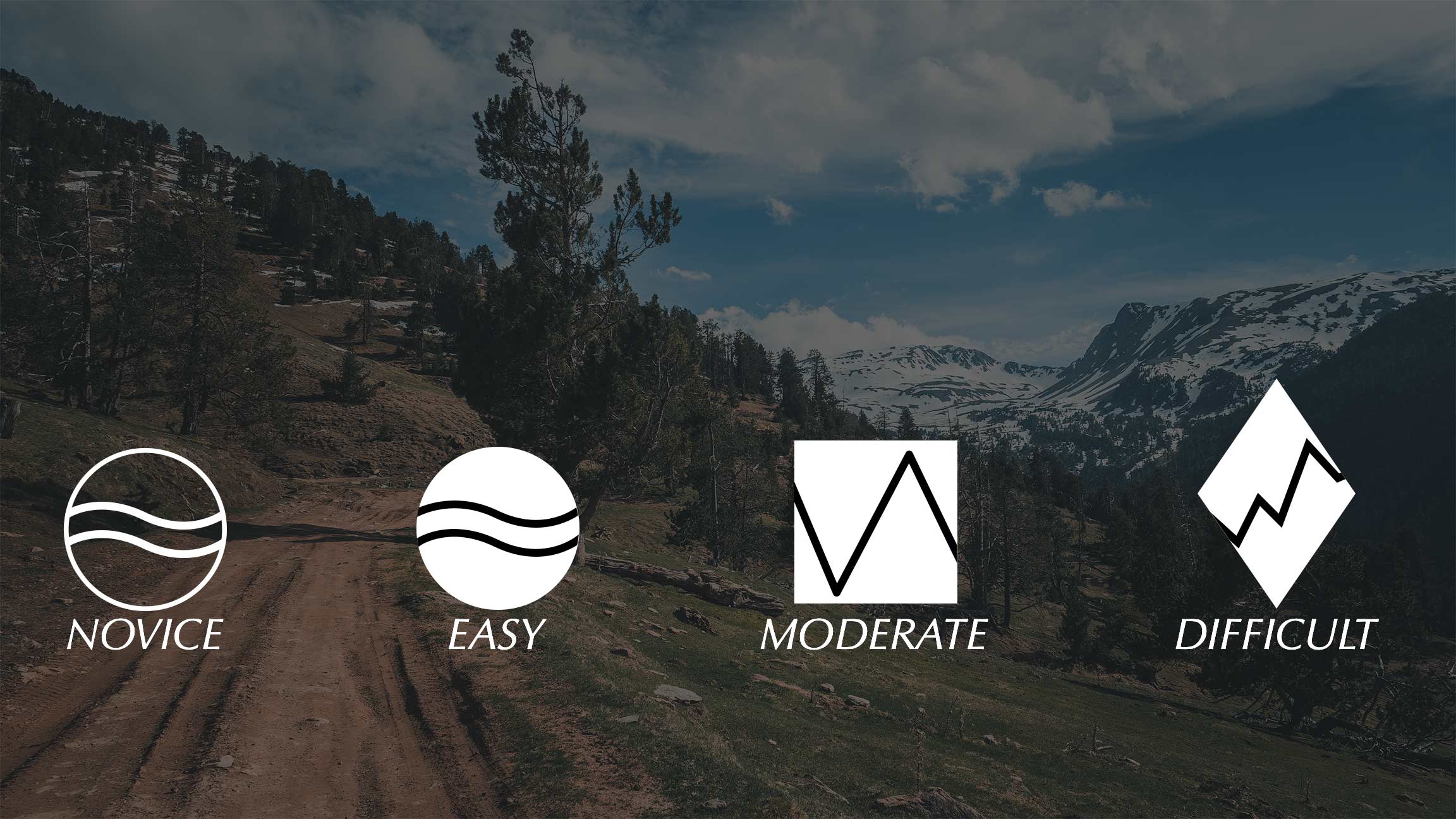How to use the Motorcycle Adventure Route Grading system?

Ever wondered if you have the skills to ride the motorcycle adventure routes of The GLR-Network? No need for doubt anymore, because this grading system helps you to find the best adventure route for you! This article explains every level of off-road routes, from novice to difficult. If you have any doubts about your riding skills, I have a great guide on how to assess your adventure riding skill level.
How motorcycle adventure routes are graded?
This article helps you to find the best level of adventure route from the GLR-Network. Each off-road route is graded according to the specifications discussed in this article below. Taken into account are road- and water features, the obstacles you may encounter, and the difficulty of hill-climbs.
Each motorcycle adventure route is graded according to its hardest feature. If this feature is not representative of the entire route, a cut-out will be available in the download section.
Besides this, I want to emphasize that mainly off-road sections are vulnerable to seasonal changes. Prolonged rainfall can degrade the road surface significantly. Therefore an adventure route can change from grade on a day-to-day basis. For this reason, there’s the possibility of downloading The Back-up Tracks. This additional route navigates you around each off-road feature. Make sure to download these for each GLR, before you head out on your adventure!
At last, we’re all great riders, and most of us have a big ego. If you don’t want to pick up your bike every half hour, I’ve included a great guide on how to determine your skill level. Riding just above your comfort level will make a great adventure. Riding way above will only break you and your motorcycle. Choose your routes responsibly.
How the GLR Grading system works.
The GLR Route Grading System consists of 4 levels of difficulty. From the Novice level, all the way up to the Difficult level. Down below, each gets explained in detail regardings its road features, water features, the obstacles you may encounter, and the hill type features. Let’s start at the Novice level.
The Adventure Novice level
The Novice, or the easiest level, is indicated by the Novice sign. According to this GLR motorcycle adventure route grading system, these routes are rideable by all riders. No adventure riding experience is required, although it of course helps.
The road features consist of old or poorly maintained paved roads. You may encounter loose gravel on paved surfaces, potholes, and medium to deep drainage didges. Off-road sections will be well maintained and consist of graded gravel and dirt roads.
Regarding the Novice level water features, you probably won’t encounter any water crossings at all. If there’s any form of water, it’ll be less than 5 centimeters deep.
On the other hand, you may encounter obstacles in the form of sticks and small tree limbs. Hills have road-like grades with modest inclines or declines.
Although I highly recommend investing in some form of adventure-oriented tires, it is possible to ride the Novice level routes with normal road tires.
The Easy level
The Easy level is suitable for those riders who already have some off-road kilometers under their belt. You know how to ride while standing up on mixed surfaces. The main difference between the Novice and the Easy level is that the off-road surface becomes more unpredictable.
Road features which are characterized in the Easy level are two-track roads, with a graded surface. You may encounter wide and shallow ruts. Short sections of packed sand surfaces are possible, and washboards may occur. Due to the less maintained nature of the Easy level roads, minor water bars may be visible on the road surface.
This is the first level where you may have to cross a river of less than 10cm of slow-moving water. The ramps and base are solid, so a good introduction to water crossings.
Other obstacles you may encounter are small sections of loose rock less than 8 centimeters in diameter. You’ll also find standing edges of 10cm like rock slates or exposed tree limbs. You may encounter patches of soft gravel, shallow sand, or surface mud.
On the inclines, you find some loose rocks or light gravel. Rain ruts will make the accent more difficult than the novice level hill climbs.

The Moderate level
At the Moderate level of the GLR motorcycle adventure route grading system, is where you’re going to need to bring some skills to the table. Remember, GLR adventure routes will never cross single track roads. But the two-track roads can become quite small when avoiding obstacles.
The road features within the Moderate level include sections of shallow mud and soft surface gravel. Ruts will narrow the track significantly and need to be crossed on the regular. Your sand riding skills will be tested on soft sand patches larger than 30 meters.
When crossing rivers, the base will be muddy with some loose surface at the ramps. The water will be less than 20cm deep and have a modest flow.
Other obstacles will come in the form of wet grass and standing edges less than 15 centimeters high. On the inclines you may encounter loose rock patches and standing shelves, again, less than 15cm high. Ruts will force you into single-lane switchback sections, which increase the difficulty of the hill climb.
The Difficult level
The Difficult level is where you are going to question yourself why you didn’t bring an enduro motorcycle instead of a heavy adventure bike. Especially the road features and hills are challenging.
You may encounter snow patches, especially on the outer edges of the rideable season and at altitude. You pass sections of loose rock, with rocks larger than 15cm in diameter. Soft sand sections will be larger than 30 meters. Some parts of a Modest route will transform into Difficult ones after rain.
Water crossings are hard and will have a loose base. Rocks may be hidden under the water surface. The depth at fast-flowing rivers less than 20cm. At modest flowing rivers, this will be less than 30cm.
To cross Difficult level obstacles, you need momentum. You may encounter deep soft gravel, more than 10cm deep. Mud and sand sections will be unpredictable and may need an inspection on foot.
On the inclines, you may find any sort of obstacle imaginable and are in general quite hard to pass the first time trying.
For the Difficult level off-road sections, there will always be a cut-out available to continue your journey.
Conclusion
It doesn’t matter at which level of the GLR adventure route grading system you find yourself. There will be plenty of routes available which fit your skill level. It’s important to know beforehand what kind of obstacles and road features you’ll encounter on your adventure. Choose your adventures wisely, and hopefully, this grading system helps you with preparing for your next motorcycle adventure!
If you’re looking for some great tips and tricks while preparing your next adventure, I cannot recommend the podcast Adventure Rider Radio enough.
